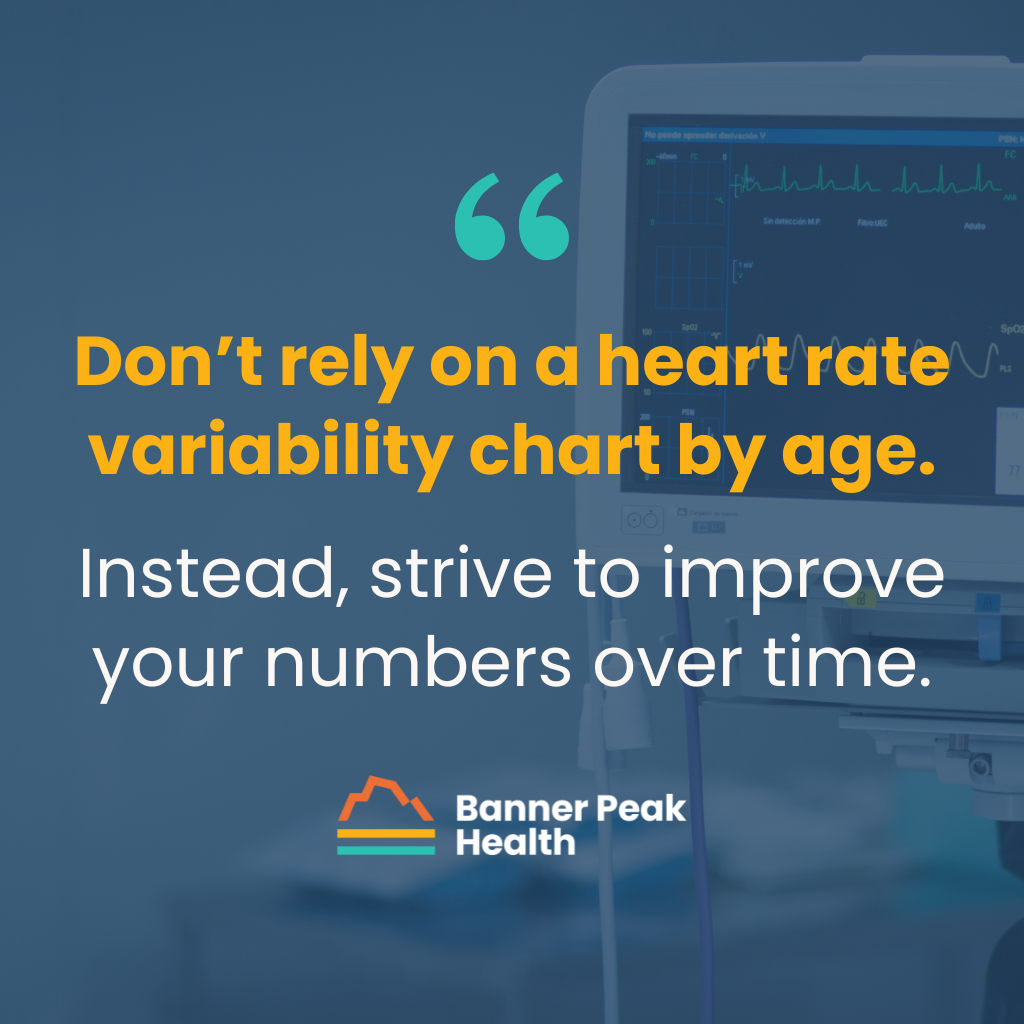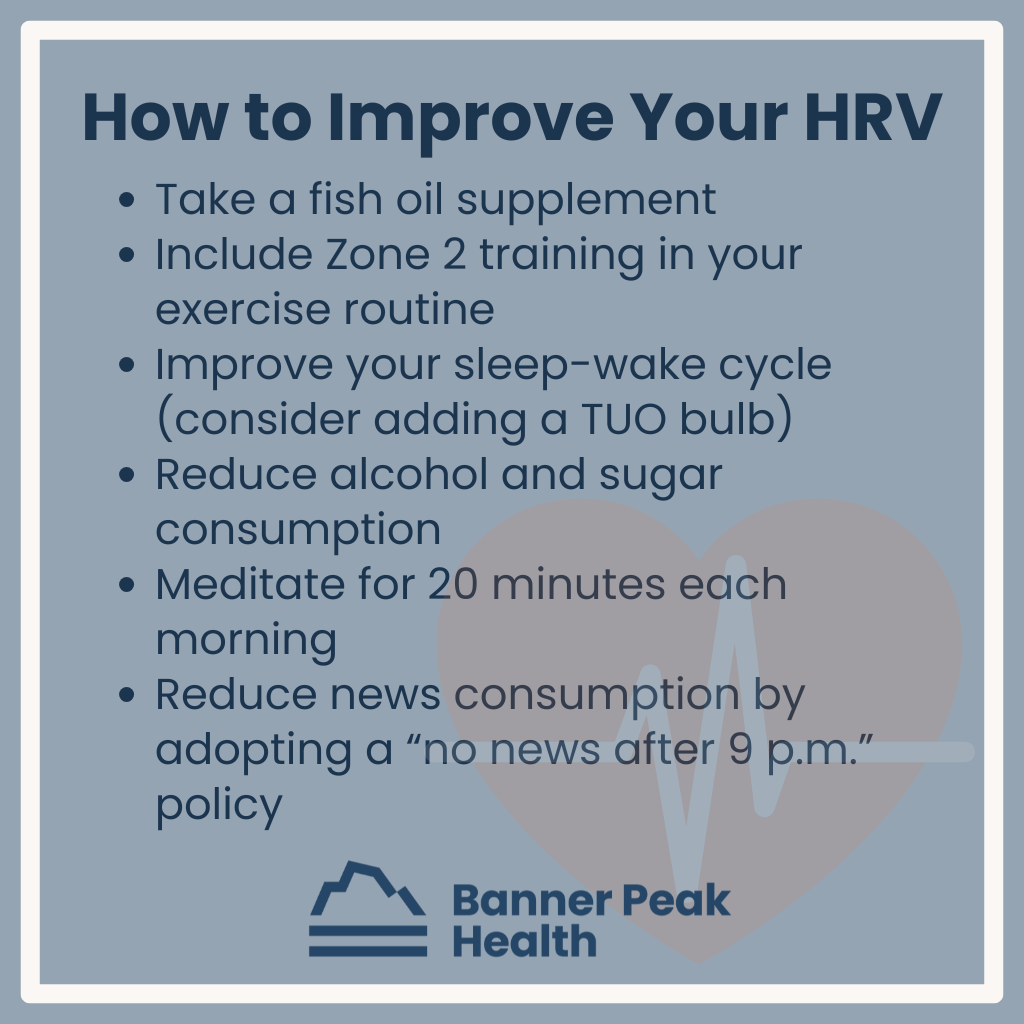Many people want to know if their heart rate variability (HRV) is normal and how to improve it.
But what is heart rate variability? Is it wise to compare your heart rate variability to a heart rate variability chart by age?
Heart Rate Variability, the Autonomic Nervous System, and Our Health
Heart rate variability measures how the spacing between heartbeats varies with respiration.
The autonomic nervous system controls your heart rate and other automatic systems in your body, like breathing. This system includes the sympathetic (fight or flight) and parasympathetic (rest and digest) nervous systems.
The graphics below demonstrate how these systems work together to determine your HRV.
When you inhale (called inspiration), your sympathetic nervous system dominates slightly and your heart rate quickens a bit. When you exhale (called expiration), your parasympathetic nervous system dominates slightly and your heart rate slows a bit. Your heart rate variability is derived from the difference between these two lengths of time.

The lower the HRV, the more dominant the sympathetic nervous system.

When the sympathetic nervous system predominates, the body is having a harder time responding to stress. Someone with a lower heart rate variability may not handle stress well.
Conversely, increased parasympathetic variability reflects how well your body maintains homeostasis — how adaptable you are to external challenges.
It’s possible and beneficial to change how your body responds to the inevitable stressors of life:
- Improve your immune system before germs infect you.
- Enhance your endocrine system to rebalance your blood glucose.
- Strengthen and stabilize yourself before you fall and break your hip.
Life is about homeostasis, but stressors try to throw us off balance. Parasympathetic variability is a good marker of stress resilience.
How Does Age Affect Heart Rate Variability?
Age is a process of losing adaptability.
As we age, it’s harder to maintain homeostasis. Any middle-aged person who’s battled a cold for weeks while their toddling grandchild improves after just a few days can attest to that. Recovery takes longer.
HRV, which maps our adaptability, declines with age. The heart rate variability chart by age below demonstrates this:

What Can We Do About It?
In medicine, we ask a fundamental question: Is the decline in function because of an inherent, immutable aging process, or is it because of some reversible cause? Is it inevitable? Can we fix it?
For instance, why is it harder to maintain muscle mass as we age? Is it because of an age-related decline in hormonal stimulus for muscle mass, or is it because of a decreased functional activity that stimulates our muscles?
Is it both? What’s the ratio? The best way to find out is to work on improving the process and see what is possible.
HRV is similar: it declines with age. Some cases are probably due to innate age-related decline, but some are also probably reversible if addressed appropriately.
HRV is new to the medical world. We physicians are constantly learning; as we do, we share new information with our patients.
What About the Heart Rate Variability Chart by Age?
The heart rate variability chart by age is deceptive. Because of inherent genetic and age-based differences, you can’t compare your values to others.
Although it’s human nature to compare ourselves to others, HRV is individual. (My experience demonstrates this — I’m 62, and my average HRV is down to 20 or 25, which is on the low end of any age-based chart.)
Your HRV is relevant only to your own changes over time. Comparing those changes gives you an accurate picture of your heart rate variability and resiliency.
Once you have an accurate baseline number, you can work to improve it.
Improving Your HRV
I wrote a blog post about HRV and how to address and improve it based on my personal experience.
Here are the CliffsNotes:
- Take a fish oil supplement
- Include Zone 2 training in your exercise routine
- Improve your sleep-wake cycle (consider adding a TUO bulb)
- Reduce alcohol and sugar consumption
- Meditate for 20 minutes each morning
- Reduce news consumption by adopting a “no news after 9 p.m.” policy
Remember, you want to beat your numbers, not anyone else’s or those you see on a heart rate variability chart by age.
How to Get an Accurate HRV Reading
HRV can be calculated and measured in different ways. For instance, if your Oura Ring says your HRV is “24,” that may differ from the heart rate variability chart by age’s “24” because each source calculates HRV differently.
Every time you measure HRV, the environmental factors must be identical and reproducible. Also, because your parasympathetic nervous system (rest and digest) determines your HRV, you must measure it when you’re resting. Try measuring at the same time every morning before you get out of bed while you’re still calm and at rest.
Don’t rely on HRV data from Apple Watches. They claim to provide HRV data “throughout the day,” but that’s impossible because of the nature of accurate HRV data.
Today’s Takeaways
As you age, your HRV declines. You probably won’t like the number you see the first time you measure it. Thankfully, it’s not set in stone. With some determination, you can change your HRV and improve your healthspan.
Don’t rely on a heart rate variability chart by age. Instead, strive to improve your numbers over time.
If you’d like help measuring or improving your HRV, don’t hesitate to schedule an appointment with our team.


Barry Rotman, MD
For over 30 years in medicine, Dr. Rotman has dedicated himself to excellence. With patients’ health as his top priority, he opened his own concierge medical practice in 2007 to practice medicine in a way that lets him truly serve their best interests.




